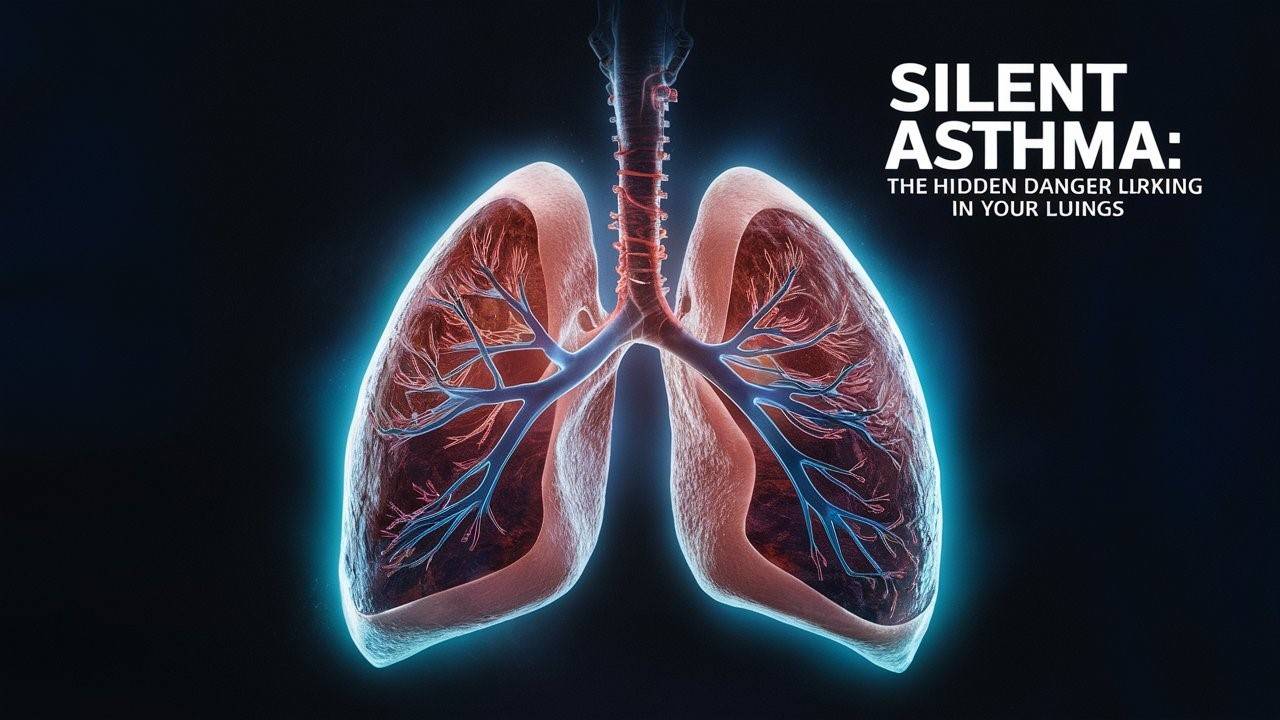Silent Asthma: The Hidden Danger Lurking in Your Lungs
Uncover the hidden threat of silent asthma lurking in your lungs. Learn symptoms, diagnosis, and treatment options to protect your respiratory health.
Quick Summary
Silent asthma is a subtle form of asthma with minimal or no symptoms. It can cause long-term lung damage if left untreated. Key signs include nighttime coughing, slight chest tightness, and mild breathlessness during exercise. Regular check-ups and lung function tests are crucial for early detection and management.
Introduction: The Whisper in Your Chest
 It is a perplexing and often overlooked respiratory condition and presents a significant challenge to both patients and healthcare providers. Unlike its more vocal counterpart, characterized by the familiar symphony of wheezing and chest tightness, silent asthma operates in the shadows, making diagnosis and management particularly difficult.
It is a perplexing and often overlooked respiratory condition and presents a significant challenge to both patients and healthcare providers. Unlike its more vocal counterpart, characterized by the familiar symphony of wheezing and chest tightness, silent asthma operates in the shadows, making diagnosis and management particularly difficult.
What is Silent Asthma?
It, also known as occult asthma or hidden asthma, is a form of asthma where the typical symptoms are mild or absent. This doesn’t mean it’s harmless – far from it.
I’ve seen patients who thought they were perfectly healthy, only to discover they had significant lung inflammation due to undiagnosed silent asthma. It’s like a stealthy intruder, quietly damaging your airways without setting off the usual alarms.
The Dangers of Undetected Silent Asthma
Silent asthma might not cause dramatic symptoms, but its long-term effects can be serious:
- Permanent airway remodelling
- Reduced lung function over time
- Increased risk of severe asthma attacks
- Complications with other respiratory conditions
Recognizing the Subtle Signs
While silent asthma is, well, silent, there are some whisper-quiet symptoms to watch out for:
- Occasional nighttime coughing
- Mild chest tightness, especially in the morning
- Slight breathlessness during or after exercise
- Increased susceptibility to respiratory infections
The Science Behind Silent Asthma
Let’s dive a bit deeper into what’s happening in your lungs with silent asthma. Even without obvious symptoms, there’s a party going on at the cellular level – and not the fun kind.
In silent asthma, your airways are experiencing low-grade inflammation. This means:
- Immune cells are on high alert
- The airway lining is slightly swollen
- Mucus production might be increased
- Airway muscles may be more reactive
All of this happens without you necessarily feeling short of breath or wheezy.
Diagnostic Challenges
Diagnosing silent asthma can be a complex process due to the absence of classic asthma symptoms. A combination of medical history, physical examination, and diagnostic tests is typically required to reach a definitive diagnosis.
- Pulmonary function tests (PFTs): While PFTs may be normal during asymptomatic periods, they can reveal abnormalities during asthma exacerbation.
- Exhaled nitric oxide (FeNO) test: Elevated levels of FeNO can indicate airway inflammation.
- Blood tests: Blood tests can help identify eosinophilia, a characteristic of silent asthma.
- Allergy testing: Identifying allergies can help determine if they contribute to airway inflammation.
- Chest imaging: Chest X-rays or CT scans may be used to rule out other lung conditions.
- Methacholine challenge test: This test can help confirm the diagnosis of asthma in individuals with normal PFTs.
Treatment and Management
While there’s no cure for silent asthma, effective management can significantly improve quality of life and prevent complications. Treatment typically involves a combination of medications and lifestyle modifications:
- Inhaled corticosteroids: These anti-inflammatory medications help reduce airway inflammation.
- Bronchodilators: These medications relax the airway muscles, providing relief from symptoms.
- Combination inhalers: These devices deliver both corticosteroids and bronchodilators in a single inhalation.
- Leukotriene modifiers: These medications help reduce airway inflammation.
- Oral corticosteroids: May be used for severe cases or during exacerbations.
- Biologic therapies: In some cases, targeted biologic therapies may be considered.
Lifestyle modifications play a crucial role in managing silent asthma:
- Allergen control: Reduce exposure to allergens through measures such as air purifiers, dust mite covers, and regular cleaning.
- Avoid irritants: Minimize exposure to tobacco smoke, air pollution, and other irritants.
- Regular exercise: Engage in regular physical activity to improve lung function.
- Weight management: Maintaining a healthy weight can help manage asthma symptoms.
- Stress management: Practice relaxation techniques to reduce stress, as it can trigger asthma symptoms.
Living with Silent Asthma
Living with silent asthma requires a proactive approach to managing symptoms and preventing exacerbations.
- Develop a personalized action plan: Work with your healthcare provider to create a tailored management plan.
- Monitor symptoms: Keep a symptom diary to track triggers and patterns.
- Use medications as prescribed: Medication adherence is essential for controlling symptoms.
- Educate yourself about the condition: Learn about silent asthma to empower yourself and make informed decisions.
- Build a support system: Connect with others who understand the challenges of living with silent asthma.
Preventing Silent Asthma
While it’s not always possible to prevent silent asthma, certain steps can help reduce the risk:
- Avoid exposure to allergens and irritants: Minimize exposure to allergens like pollen, dust mites, and pet danger. Avoid smoking and secondhand smoke.
- Maintain a healthy lifestyle: Regular exercise, a balanced diet, and adequate sleep can help strengthen the immune system.
- Manage stress: Practice relaxation techniques to reduce stress levels.
- Early treatment of respiratory infections: Promptly treat colds and other respiratory infections to prevent complications.
- Regular check-ups: Schedule regular check-ups with your healthcare provider to monitor lung health.
It is a complex condition that requires a comprehensive approach to diagnosis and management. By working closely with your healthcare provider, implementing appropriate treatment strategies, and adopting healthy lifestyle habits, you can effectively manage symptoms and improve your quality of life.
FAQs About Silent Asthma
How do you fix silent asthma?
Silent asthma isn’t “fixed” but is managed through regular medication (usually inhaled corticosteroids), lifestyle adjustments, and monitoring. The goal is to reduce inflammation and prevent lung damage.
How to tell asthma from anxiety? While both can cause breathlessness, asthma symptoms usually respond to asthma medications and may be triggered by specific allergens or activities. Anxiety-related breathing issues often come with other anxiety symptoms and may be situational.
What is the life expectancy of a person with asthma?
With proper management, most people with asthma, including silent asthma, can expect a normal life expectancy. The key is early diagnosis and consistent treatment to prevent long-term lung damage.
Why have I suddenly developed asthma?
Asthma can develop at any age due to various factors, including allergies, respiratory infections, occupational exposures, or changes in hormone levels. Silent asthma might have been present for a while before becoming noticeable.
Conclusion: Breaking the Silence
Living with silent asthma doesn’t mean living in fear. By staying informed, vigilant, and proactive about your lung health, you can keep this sneaky condition in check. Remember, your lungs might be whispering – make sure you’re listening!
Thank you for taking the time to learn about silent asthma. Your lungs will thank you for it!
Recommended Reading:
- Unusual Asthma Symptoms Decoded: Unmasking Surprising Red Flag
- Yoga for Lung Health: Breathe Easy with These 9 Powerful Poses
- 10 signs that you are in good health: Are You Checking All the Boxes?
Note: This information is intended for educational purposes only and does not replace professional medical advice. Always consult with a healthcare provider for diagnosis and treatment.



